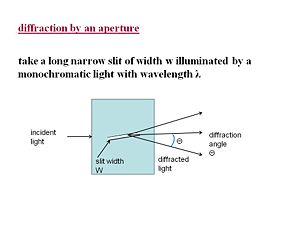Diffraction of Light
Return to Basics of Light Menu
Light can be diffracted Diffraction effects occur when waves interact with objects having a size similar to the wavelength of radiation. Diffraction is not an important for optical fibers because there must be some specific order in the materials in order to have a diffraction pattern. When light goes through a slit there are two regimes that have been explored; close to the object as in Fresnel diffraction, and the effects of diffraction far from the object: Fraunhofer diffraction.
The result of diffraction is a set of bright and dark fringes, due to constructive and destructive wave interference, called a diffraction pattern.
The intensity observed far from the slit is given by:
<math>I = I_0 (\frac {sin\lambda} {\lambda} sinx/x)^2\,\!</math>
where Where <math>x = w sin(\frac {\theta}{\lambda})\,\!</math>
minima are found for Θ values such that:
Sin theta min = j (lambda/ w)
with j = ±1, ±2, ±3, … Therefore: the narrower the slit, the wider the fringe spacing
